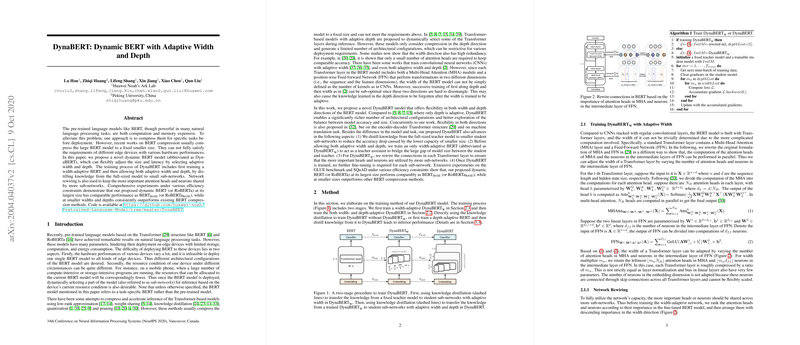An Analysis of DynaBERT: Dynamic BERT with Adaptive Width and Depth
The paper "DynaBERT: Dynamic BERT with Adaptive Width and Depth" introduces a transformative approach to pre-trained LLM deployment, particularly addressing the challenges posed by the substantial computational and memory demands of models like BERT. The proposal is to use DynaBERT, which allows for an adaptive configuration of BERT both in width and depth, making it versatile enough to be deployed across a range of devices with varying resource constraints.
Methodology and Innovations
The authors propose a two-stage training process for DynaBERT:
- Width-Adaptive Training: Initially, DynaBERT is trained to be adaptable in terms of its width. This is achieved by varying the number of attention heads in the Multi-Head Attention (MHA) and the number of neurons in the Feed-Forward Network (FFN) within each Transformer layer. Network rewiring is employed, wherein connections are reorganized to prioritize attention heads and neurons that hold greater importance, thus ensuring these are shared among more sub-networks.
- Width- and Depth-Adaptive Training: Subsequently, DynaBERT is further trained to be flexible both in width and depth. This flexibility is realized by selecting different numbers of Transformer layers, wherein knowledge is distilled from the full-sized model to smaller sub-networks. The authors emphasize the detrimental impact of catastrophic forgetting when allowing flexibility in depth, an issue addressed by integrating both dimensions together and prioritizing width in the adaptive sequence.
Experimental Results
The paper reports extensive experimental validation of DynaBERT's efficacy across a variety of natural language processing benchmarks, primarily on the GLUE benchmark and SQuAD v1.1. The results are compelling:
- At its largest configuration, DynaBERT maintains parity with standard BERT in performance, demonstrating that the flexibility afforded in model architecture does not compromise accuracy.
- Smaller configurations of DynaBERT consistently outperform fixed-size, compressed BERT alternatives across most setups, particularly when evaluated under constraints such as the number of parameters, FLOPs, and device-specific latency.
Implications and Future Directions
The implications of this work are noteworthy for the deployment of NLP models in edge computing environments, where resource variability is a significant concern. DynaBERT provides a compelling solution by offering a model that can dynamically adjust its computational footprint based on the current hardware scenario. This innovation is particularly valuable for democratizing AI, facilitating the deployment of sophisticated NLP models on lower-end devices where fixed-size models could not feasibly run.
Additionally, this dynamic training approach hints at broader applications beyond just BERT or Transformer-based models, suggesting a new direction in model development that could potentially include adaptive training mechanisms for other deep learning architectures.
Future research could expand upon the DynaBERT framework, exploring further optimization of network reconfiguration strategies and investigating the potential for multitask training to enhance efficiency. Moreover, as machine readability and robustness become increasingly critical, adaptive models like DynaBERT represent an exciting frontier in making AI deployment both effective and efficient across a myriad of hardware constraints, encouraging further academic and practical exploration.
